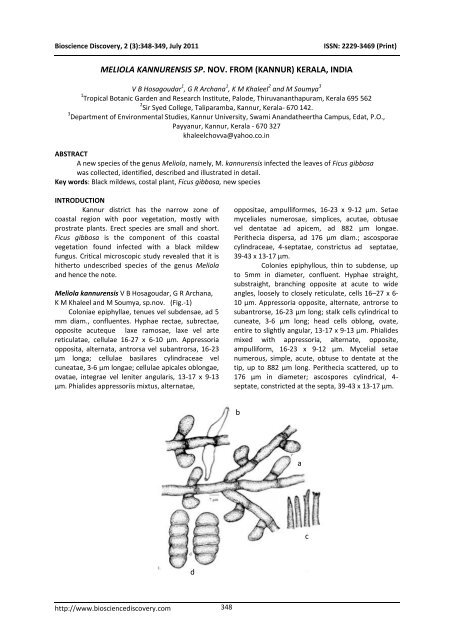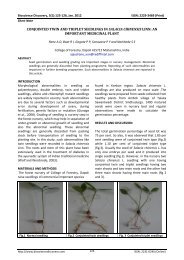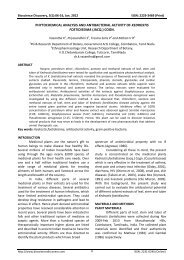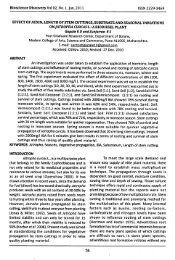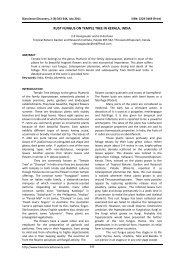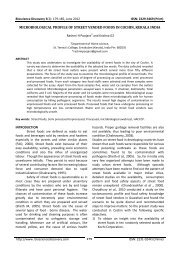meliola kannurensis sp. nov. from (kannur) - Bioscience Discovery
meliola kannurensis sp. nov. from (kannur) - Bioscience Discovery
meliola kannurensis sp. nov. from (kannur) - Bioscience Discovery
You also want an ePaper? Increase the reach of your titles
YUMPU automatically turns print PDFs into web optimized ePapers that Google loves.
<strong>Bioscience</strong> <strong>Discovery</strong>, 2 (3):348-349, July 2011 ISSN: 2229-3469 (Print)<br />
MELIOLA KANNURENSIS SP. NOV. FROM (KANNUR) KERALA, INDIA<br />
V B Hosagoudar 1 , G R Archana 1 , K M Khaleel 2 and M Soumya 3<br />
1 Tropical Botanic Garden and Research Institute, Palode, Thiruvananthapuram, Kerala 695 562<br />
2 Sir Syed College, Taliparamba, Kannur, Kerala- 670 142.<br />
3 Department of Environmental Studies, Kannur University, Swami Anandatheertha Campus, Edat, P.O.,<br />
Payyanur, Kannur, Kerala - 670 327<br />
khaleelchovva@yahoo.co.in<br />
ABSTRACT<br />
A new <strong>sp</strong>ecies of the genus Meliola, namely, M. <strong><strong>kannur</strong>ensis</strong> infected the leaves of Ficus gibbosa<br />
was collected, identified, described and illustrated in detail.<br />
Key words: Black mildews, costal plant, Ficus gibbosa, new <strong>sp</strong>ecies<br />
INTRODUCTION<br />
Kannur district has the narrow zone of<br />
coastal region with poor vegetation, mostly with<br />
prostrate plants. Erect <strong>sp</strong>ecies are small and short.<br />
Ficus gibbosa is the component of this coastal<br />
vegetation found infected with a black mildew<br />
fungus. Critical microscopic study revealed that it is<br />
hitherto undescribed <strong>sp</strong>ecies of the genus Meliola<br />
and hence the note.<br />
Meliola <strong><strong>kannur</strong>ensis</strong> V B Hosagoudar, G R Archana,<br />
K M Khaleel and M Soumya, <strong>sp</strong>.<strong>nov</strong>. (Fig.-1)<br />
Coloniae epiphyllae, tenues vel subdensae, ad 5<br />
mm diam., confluentes. Hyphae rectae, subrectae,<br />
opposite acuteque laxe ramosae, laxe vel arte<br />
reticulatae, cellulae 16-27 x 6-10 µm. Appressoria<br />
opposita, alternata, antrorsa vel subantrorsa, 16-23<br />
µm longa; cellulae basilares cylindraceae vel<br />
cuneatae, 3-6 µm longae; cellulae apicales oblongae,<br />
ovatae, integrae vel leniter angularis, 13-17 x 9-13<br />
µm. Phialides appressoriis mixtus, alternatae,<br />
http://www.biosciencediscovery.com<br />
d<br />
348<br />
oppositae, ampulliformes, 16-23 x 9-12 µm. Setae<br />
myceliales numerosae, simplices, acutae, obtusae<br />
vel dentatae ad apicem, ad 882 µm longae.<br />
Perithecia di<strong>sp</strong>ersa, ad 176 µm diam.; asco<strong>sp</strong>orae<br />
cylindraceae, 4-septatae, constrictus ad septatae,<br />
39-43 x 13-17 µm.<br />
Colonies epiphyllous, thin to subdense, up<br />
to 5mm in diameter, confluent. Hyphae straight,<br />
substraight, branching opposite at acute to wide<br />
angles, loosely to closely reticulate, cells 16–27 x 6-<br />
10 µm. Appressoria opposite, alternate, antrorse to<br />
subantrorse, 16-23 µm long; stalk cells cylindrical to<br />
cuneate, 3-6 µm long; head cells oblong, ovate,<br />
entire to slightly angular, 13-17 x 9-13 µm. Phialides<br />
mixed with appressoria, alternate, opposite,<br />
ampulliform, 16-23 x 9-12 µm. Mycelial setae<br />
numerous, simple, acute, obtuse to dentate at the<br />
tip, up to 882 µm long. Perithecia scattered, up to<br />
176 µm in diameter; asco<strong>sp</strong>ores cylindrical, 4septate,<br />
constricted at the septa, 39-43 x 13-17 µm.<br />
b<br />
a<br />
c
Hosagoudar et al. ISSN: 2231-024X (Online)<br />
EXPLANATION TO LINE DRAWINGS<br />
Fig. 1. Meliola mutabilidis <strong>sp</strong>.<strong>nov</strong>.<br />
a-Appressorium, b- Phialide, c-Apical portion of the<br />
mycelial setae, d-Asco<strong>sp</strong>ores<br />
Materials examined:<br />
On leaves of Ficus gibbosa Bl. (Moraceae), Edat,<br />
Payyannur, Kannur, Jan.21, 2011, M. Soumya TBGT<br />
4942 (holotype). Part of the collection has been<br />
deposited in HCIO, New Delhi.<br />
LITERATURE CITED<br />
Hansford CG. 1961. The Meliolineae. A Monograph. Sydowia. Beih. 2: 1-806.<br />
http://www.biosciencediscovery.com<br />
349<br />
Based on the alternate and opposite<br />
appressoria, Meliola <strong><strong>kannur</strong>ensis</strong> is similar to M.<br />
chlorophorae Hansf. reported on Chlorophora<br />
excelsa <strong>from</strong> Uganda but differs <strong>from</strong> it having both<br />
acute, obtuse and dentate and longer mycelial setae<br />
(Hansford 1961).<br />
ACKNOWLEDGEMENT<br />
We thank the Director, Tropical Botanic Garden<br />
and Research Institute, Palode for the facilities.


